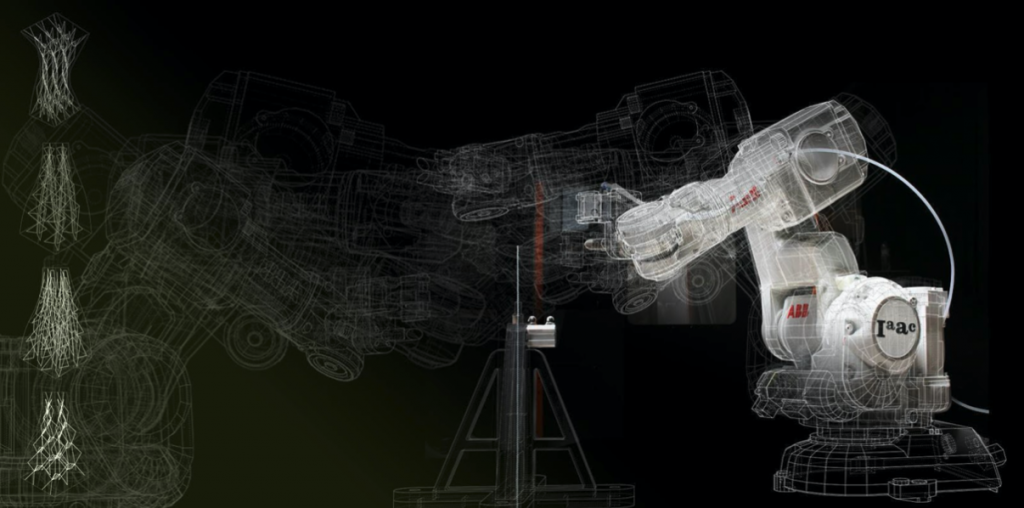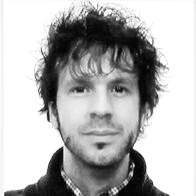INTRODUCTION TO ROBOTIC FABRICATION
EXPLORING POSSIBLE APPLICATIONS OF ROBOTIC FABRICATION FOR ARCHITECTURE
Faculty: Ricardo Mayor & Lana Awad

Credits: IAAC GSS Design for Robotics, 2020
Robotics has opened up new avenues of designing, making, assembling and indeed the whole spectrum of architectural production. Although robots, particularly industrial robots, have been around since the 1960s, have not yet been directly linked to the design process.
The construction sector has not yet taken full advantage of the digital revolution that is happening in other manufacturing sectors, such as in the automobile and aerospatial engineering industries. While studies predict that Automation, Robotics, and AI will possibly increase productivity by 60% in the construction sector, they also open new opportunities for design and for increased building performance.
In this context, today we find ourselves looking at the midst of a significant transformation regarding the way we produce products thanks to the digitization of manufacturing. This brings us to the emergence of a community of research and education centers including IAAC exploring new fabrication methods that can be more efficient, sustainable, and customisable thanks to the use of robotic fabrication within its educational programs, consolidating an emerging paradigm within the current production system.
To quote Richard Sennett,”Making is thinking”, this seminar will focus on a manufacturing driven design approach towards conceiving spaces. Students are offered the opportunity to learn and explore robotic fabrication within IAAC’s particularly open environment for direct manipulation and testing. In parallel, students are encouraged to develop a design protocol suitable for robotic fabrication that could serve to envision an application at architectural scale.
The seminar will conclude with a robotically fabricated prototype fabrication, together with a video of the design process, the prototype fabrication and the envisioned architecture.

Credits: MAA01 Robotic Fabrication Seminar, 2018/19
Learning Objectives
At course completion the student will:
- Have an overview of the possible robotic fabrication processes available for architects and designers;
- Understand the basics of robotic kinematics, robotic simulation and robotic control;
- Be capable of generating the robotic simulation and production files to produce a prototype;
- Be capable of integrating the limitations and opportunities of a specific robotics process into a final architecture design.
Faculty

Ricardo Mayor is a Master in Architecture Superior Technical School of Architecture of Alcalá de H. in Madrid and a Master Degree in Advanced Architecture from IAAC (Spain).
He graduated in 2012, obtaining a prize for his academic results and a further one for his final project. Since then he is one of the four founders of Design of Architectural Territories – DAT Pangea – who was awarded the first prize for the Best Young Architects in Europe for their Sustainable construction by LafargeHolcim Foundation.
His working career has been mainly developed in architectural and engineering offices in Madrid, Barcelona and Paris, taking part in internationally recognized projects with international architects such as Frank Ghery or OMA.
His main research faces themes such as design, fabrication and politics, focusing in particular on social issues to suitable solutions, and he implements them through his professional and academic practice.

Lana Awad is a Jordanian architect and researcher specializing in digital fabrication in Architecture. She holds a Bachelor’s degree of Architecture from the American University of Sharjah (UAE, 2010) and a Master Degree in Advanced Architecture from IAAC (Spain, 2013), specializing in digital fabrication and large-scale additive manufacturing in architecture. Additionally, she also completed the Fab Academy programme and was selected to complete her research through the Fab Thesis programme.
Her work since has focused strongly on digital fabrication within social studies and political contexts. She was the Creative Director for Refugee Open Ware, a global innovation consortium aimed at employing advanced technology for the advancement of human rights in conflict zones. After which she became Project Manager for Atta33, a digital fabrication laboratory and co-making workshop in Poblenou. Her personal projects range from conceptual VR projects on identity and empathy (The Machine to be Another) to designing 3D printed prosthetics for Syrian refugees. More recently she has been collaborating with several architecture offices including External Reference Architects, Cloud9, and Built by Associative Data.